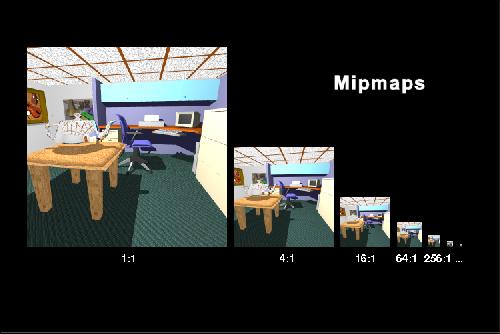MIP-mapping
In extrem situtation, the best is to use MIP-mapping
-
Multum in Parvo, or many in a small place
-
pre-computes part of the filter operation by storing down-sampled replicas of each texture
Since many texels will probably map to each pixel, it would be extremely expensive to perform the entire filter computation at each pixel, each frame. MIP-mapping (Multum in Parvo, or many in a small place) pre-computes part of the filter operation by storing down-sampled replicas of each texture, going from the original m x n texture map all the way to a 1 x 1 texture map. At run time, if a given screen pixel maps to many texels, we simply choose the appropriate MIP-map level in which a single texel represents all the desired texels, and perform our texture sampling on that level.
Since the pixel will project to an arbitrary place on the MIP-map image, rather than exactly onto a texel, we can use bilinear or other filtering to interpolate nearby texels. This is Bilinear MIP-mapped Texture Filtering talked about in video game hardware. Better than this, we can bilinearly filter on the two most appropriate MIP-map levels and then blend the results. This is Trilinear MIP-mapped Texture Filtering. It requires the use of eight texels, and requires seven linear interpolations, but provides an important improvement over bilinear filtering.
